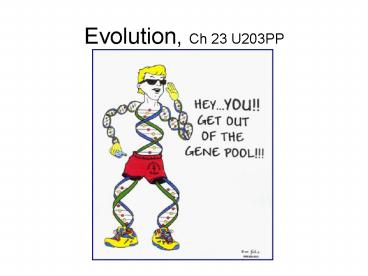Evolution, Ch 23 U203PP PowerPoint PPT Presentation
1 / 18
Title: Evolution, Ch 23 U203PP
1
Evolution, Ch 23 U203PP
2
- Overview The Smallest Unit of Evolution
- One common misconception about evolution is that
individual organisms evolve, in the Darwinian
sense, during their lifetimes - Natural selection acts on individuals, but
populations evolve
3
We know there is considerable genetic variation
in populations
- Electrophoresis
- DNA sequencing
- Chemical analysis of proteins
so how does this variation translate into allele
frequency changes in a population, i.e., how does
microevolution occur?
4
- Concept 23.1 Population genetics provides a
foundation for studying evolution - Microevolution
- Is change in the genetic makeup of a population
from generation to generation
Darwin would suggest that small changes
(microevolution) within a population would
accumulate and lead to bigger changes that would
result in the development of new species
(macroevolution)
5
An organism exposes its phenotype to the
environment
- Acting on phenotypes, though, natural selection
adapts a population by increasing or maintaining
favored genotypes in the gene pool
Uh. Phenotype? Genotype? I should know these
from freshman bio, right?
6
- Phenotype behavior, physical traits, appearance,
physiology, metabolism - Genotype the combination of alleles that make up
the trait
Alleles? Isnt that another word I should know?
Alleles are VERSIONS of genes you may have for a
particular trait for which there is one gene (two
alleles)
If the alleles are the same homozygous If the
allele are different heterozygous
7
Gene Pools and Allele Frequencies
- A population
- Is a localized group of individuals that are
capable of interbreeding and producing fertile
offspring
8
- The gene pool
- Is the total aggregate of genes in a population
at any one time - Consists of all gene loci in all individuals of
the population
9
The Modern Synthesis
- Population genetics
- Is the study of how populations change
genetically over time - Reconciled Darwins and Mendels ideas
- Integrates Mendelian genetics with the Darwinian
theory of evolution by natural selection - Focuses on populations as units of evolution
10
The Hardy-Weinberg Theorem
- The Hardy-Weinberg theorem
- Describes a population that is not evolving
- States that the frequencies of alleles and
genotypes in a populations gene pool remain
constant from generation to generation provided
that only Mendelian segregation and recombination
of alleles are at work
11
- Mendelian inheritance
- Preserves genetic variation in a population
12
Preservation of Allele Frequencies
- In a given population where gametes contribute to
the next generation randomly, allele frequencies
will not change
13
Hardy-Weinberg Equilibrium
- Hardy-Weinberg equilibrium
- Describes a population in which random mating
occurs - Describes a population where allele frequencies
do not change
14
- A population in Hardy-Weinberg equilibrium
15
- If p and q represent the relative frequencies of
the only two possible alleles in a population at
a particular locus, then - p2 2pq q2 1
- And p2 and q2 represent the frequencies of the
homozygous genotypes and 2pq represents the
frequency of the heterozygous genotype
16
Conditions for Hardy-Weinberg Equilibrium
- The Hardy-Weinberg theorem
- Describes a hypothetical population
- In real populations
- Allele and genotype frequencies do change over
time
17
- The five conditions for non-evolving populations
are rarely met in nature - Extremely large population size
- No gene flow
- No mutations
- Random mating
- No natural selection
18
Population Genetics and Human Health
- We can use the Hardy-Weinberg equation
- To estimate the percentage of the human
population carrying the allele for an inherited
disease

